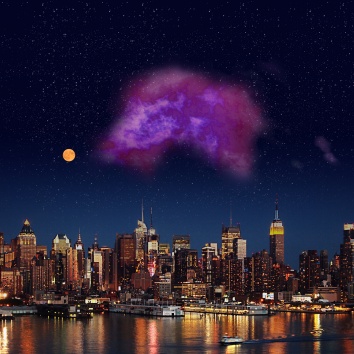
Artistic representation of what the Eos molecular cloud would look like in the sky if it were visible to the naked eye (and purple!). Image credit: NatureLifePhoto / Flickr (New York City Skyline), Burkhart et al. 2025
28 April 2025
An international team of scientists, including from McDonald Observatory at The University of Texas at Austin, has discovered a potentially star-forming cloud that is one of the largest single structures in the sky and among the closest to the Sun and Earth ever to be detected.
The cloud of gas is located about 300 light years away. Scientists estimate that it would look vast to stargazers on Earth - if it were visible - measuring about 40 moons across the sky. Its mass is estimated as roughly 3,400 times that of the Sun.
The gigantic ball of hydrogen was recently revealed by looking for its main ingredient: molecular hydrogen. The finding marks the first time a molecular cloud has been detected with light from the hydrogen molecule emitted in the far-ultraviolet realm of the electromagnetic spectrum and opens the way to further explorations using the approach.
The scientists have named the cloud “Eos,” after the goddess of dawn in Greek mythology. Their discovery is outlined in a study published April 28 in Nature Astronomy.
“This opens up new possibilities for studying the molecular universe,” said Blakesley Burkhart, an associate professor at Rutgers School of Arts and Sciences who is a lead author on the study.
Molecular clouds are composed of gas and dust – with the most common molecule being hydrogen, the fundamental building block of stars and planets. They also contain other molecules such as carbon monoxide. Molecular clouds are often detected using conventional methods such as radio and infrared observations that easily pick up the chemical signature for carbon monoxide.
However, for this work, the scientists employed a different approach. “This is the first-ever molecular cloud discovered by looking for far ultraviolet emission of molecular hydrogen directly,” Burkhart said. “The data showed glowing hydrogen molecules detected via fluorescence in the far ultraviolet. This cloud is literally glowing in the dark.”
Because of its proximity, the gas cloud presents a unique opportunity to study the properties of a structure within the interstellar medium. This is the gas and dust that fills the space between stars within a galaxy. “It’s where stars form,” explained B-G Andersson, an astronomer at McDonald Observatory and an author on the study. “So, if you want to understand how and why stars form, you need to understand the interstellar medium.”
“When we look through our telescopes, we catch whole solar systems in the act of forming, but we don’t know in detail how that happens,” Burkhart added. “Our discovery of Eos is exciting because we can now directly measure how molecular clouds are forming and dissociating, and how a galaxy begins to transform interstellar gas and dust into stars and planets.”
Eos was revealed to the team in data collected by a far-ultraviolet spectrograph called FIMS-SPEAR (an acronym for fluorescent imaging spectrograph) that operated as an instrument on the Korean satellite STSAT-1. A far-ultraviolet spectrograph breaks down far-ultraviolet light emitted by a material into its component wavelengths, just as a prism does with visible light, creating a spectrum that scientists can analyze.
The findings highlight the importance of innovative observational techniques in advancing the understanding of the cosmos. Eos is dominated by molecular hydrogen gas but is mostly “CO-dark,” meaning it doesn’t contain much of the material and doesn’t emit the characteristic signature detected by conventional approaches. “CO is usually assumed to be an indicator of the presence of molecular gas. But it isn’t always,” said Andersson. The scarcity of CO in Eos explains how it eluded being identified for so long.
“The use of the far ultraviolet fluorescence emission technique could rewrite our understanding of the interstellar medium,” said Thavisha Dharmawardena, a NASA Hubble Fellow at New York University and a shared first author of the study. “[It could uncover] hidden clouds across the galaxy and even out to the furthest detectable limits of cosmic dawn.”
Other members of the scientific team included researchers from: Technion-Israel Institute of Technology, Haifa, Israel; Queen Mary University of London; University of Iowa, Iowa City, Iowa; Korea Astronomy and Space Science Institute, University of Science and Technology, and Korea Advanced Institute of Science and Technology, all of Daejeon, South Korea; Max Planck Institute for Astronomy, Heidelberg, Germany; University of Arizona, Tucson, Ariz.; University of California, Berkeley; Université Paris Cité, Gif-sur-Yvette, France; Space Telescope Science Institute and Johns Hopkins University, Baltimore; University of British Columbia, Vancouver, Canada; Columbia University, New York; and the Harvard-Smithsonian Center for Astrophysics, Cambridge, Mass.
Based on a press release by Rutgers University New Brunswick.

Artistic representation of what the Eos molecular cloud would look like in the sky if it were visible to the naked eye (and purple!). Image credit: NatureLifePhoto / Flickr (New York City Skyline), Burkhart et al. 2025